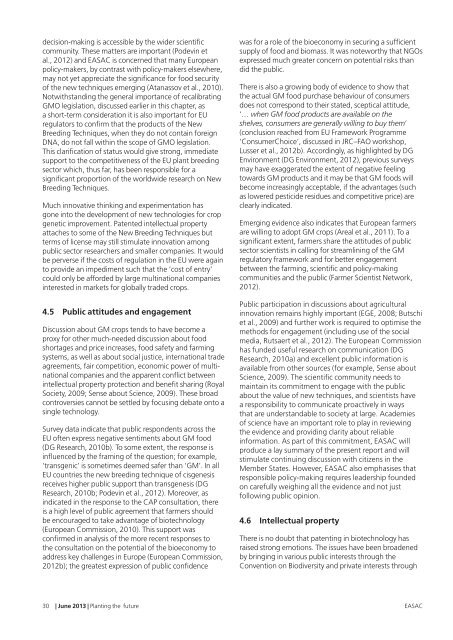Planting the future: opportunities and challenges for using ... - EASAC
Planting the future: opportunities and challenges for using ... - EASAC
Planting the future: opportunities and challenges for using ... - EASAC
Create successful ePaper yourself
Turn your PDF publications into a flip-book with our unique Google optimized e-Paper software.
decision-making is accessible by <strong>the</strong> wider scientific<br />
community. These matters are important (Podevin et<br />
al., 2012) <strong>and</strong> <strong>EASAC</strong> is concerned that many European<br />
policy-makers, by contrast with policy-makers elsewhere,<br />
may not yet appreciate <strong>the</strong> significance <strong>for</strong> food security<br />
of <strong>the</strong> new techniques emerging (Atanassov et al., 2010).<br />
Notwithst<strong>and</strong>ing <strong>the</strong> general importance of recalibrating<br />
GMO legislation, discussed earlier in this chapter, as<br />
a short-term consideration it is also important <strong>for</strong> EU<br />
regulators to confirm that <strong>the</strong> products of <strong>the</strong> New<br />
Breeding Techniques, when <strong>the</strong>y do not contain <strong>for</strong>eign<br />
DNA, do not fall within <strong>the</strong> scope of GMO legislation.<br />
This clarification of status would give strong, immediate<br />
support to <strong>the</strong> competitiveness of <strong>the</strong> EU plant breeding<br />
sector which, thus far, has been responsible <strong>for</strong> a<br />
significant proportion of <strong>the</strong> worldwide research on New<br />
Breeding Techniques.<br />
Much innovative thinking <strong>and</strong> experimentation has<br />
gone into <strong>the</strong> development of new technologies <strong>for</strong> crop<br />
genetic improvement. Patented intellectual property<br />
attaches to some of <strong>the</strong> New Breeding Techniques but<br />
terms of license may still stimulate innovation among<br />
public sector researchers <strong>and</strong> smaller companies. It would<br />
be perverse if <strong>the</strong> costs of regulation in <strong>the</strong> EU were again<br />
to provide an impediment such that <strong>the</strong> ‘cost of entry’<br />
could only be af<strong>for</strong>ded by large multinational companies<br />
interested in markets <strong>for</strong> globally traded crops.<br />
4.5 Public attitudes <strong>and</strong> engagement<br />
Discussion about GM crops tends to have become a<br />
proxy <strong>for</strong> o<strong>the</strong>r much-needed discussion about food<br />
shortages <strong>and</strong> price increases, food safety <strong>and</strong> farming<br />
systems, as well as about social justice, international trade<br />
agreements, fair competition, economic power of multinational<br />
companies <strong>and</strong> <strong>the</strong> apparent conflict between<br />
intellectual property protection <strong>and</strong> benefit sharing (Royal<br />
Society, 2009; Sense about Science, 2009). These broad<br />
controversies cannot be settled by foc<strong>using</strong> debate onto a<br />
single technology.<br />
Survey data indicate that public respondents across <strong>the</strong><br />
EU often express negative sentiments about GM food<br />
(DG Research, 2010b). To some extent, <strong>the</strong> response is<br />
influenced by <strong>the</strong> framing of <strong>the</strong> question; <strong>for</strong> example,<br />
‘transgenic’ is sometimes deemed safer than ‘GM’. In all<br />
EU countries <strong>the</strong> new breeding technique of cisgenesis<br />
receives higher public support than transgenesis (DG<br />
Research, 2010b; Podevin et al., 2012). Moreover, as<br />
indicated in <strong>the</strong> response to <strong>the</strong> CAP consultation, <strong>the</strong>re<br />
is a high level of public agreement that farmers should<br />
be encouraged to take advantage of biotechnology<br />
(European Commission, 2010). This support was<br />
confirmed in analysis of <strong>the</strong> more recent responses to<br />
<strong>the</strong> consultation on <strong>the</strong> potential of <strong>the</strong> bioeconomy to<br />
address key <strong>challenges</strong> in Europe (European Commission,<br />
2012b); <strong>the</strong> greatest expression of public confidence<br />
was <strong>for</strong> a role of <strong>the</strong> bioeconomy in securing a sufficient<br />
supply of food <strong>and</strong> biomass. It was noteworthy that NGOs<br />
expressed much greater concern on potential risks than<br />
did <strong>the</strong> public.<br />
There is also a growing body of evidence to show that<br />
<strong>the</strong> actual GM food purchase behaviour of consumers<br />
does not correspond to <strong>the</strong>ir stated, sceptical attitude,<br />
‘… when GM food products are available on <strong>the</strong><br />
shelves, consumers are generally willing to buy <strong>the</strong>m’<br />
(conclusion reached from EU Framework Programme<br />
‘ConsumerChoice’, discussed in JRC–FAO workshop,<br />
Lusser et al., 2012b). Accordingly, as highlighted by DG<br />
Environment (DG Environment, 2012), previous surveys<br />
may have exaggerated <strong>the</strong> extent of negative feeling<br />
towards GM products <strong>and</strong> it may be that GM foods will<br />
become increasingly acceptable, if <strong>the</strong> advantages (such<br />
as lowered pesticide residues <strong>and</strong> competitive price) are<br />
clearly indicated.<br />
Emerging evidence also indicates that European farmers<br />
are willing to adopt GM crops (Areal et al., 2011). To a<br />
significant extent, farmers share <strong>the</strong> attitudes of public<br />
sector scientists in calling <strong>for</strong> streamlining of <strong>the</strong> GM<br />
regulatory framework <strong>and</strong> <strong>for</strong> better engagement<br />
between <strong>the</strong> farming, scientific <strong>and</strong> policy-making<br />
communities <strong>and</strong> <strong>the</strong> public (Farmer Scientist Network,<br />
2012).<br />
Public participation in discussions about agricultural<br />
innovation remains highly important (EGE, 2008; Butschi<br />
et al., 2009) <strong>and</strong> fur<strong>the</strong>r work is required to optimise <strong>the</strong><br />
methods <strong>for</strong> engagement (including use of <strong>the</strong> social<br />
media, Rutsaert et al., 2012). The European Commission<br />
has funded useful research on communication (DG<br />
Research, 2010a) <strong>and</strong> excellent public in<strong>for</strong>mation is<br />
available from o<strong>the</strong>r sources (<strong>for</strong> example, Sense about<br />
Science, 2009). The scientific community needs to<br />
maintain its commitment to engage with <strong>the</strong> public<br />
about <strong>the</strong> value of new techniques, <strong>and</strong> scientists have<br />
a responsibility to communicate proactively in ways<br />
that are underst<strong>and</strong>able to society at large. Academies<br />
of science have an important role to play in reviewing<br />
<strong>the</strong> evidence <strong>and</strong> providing clarity about reliable<br />
in<strong>for</strong>mation. As part of this commitment, <strong>EASAC</strong> will<br />
produce a lay summary of <strong>the</strong> present report <strong>and</strong> will<br />
stimulate continuing discussion with citizens in <strong>the</strong><br />
Member States. However, <strong>EASAC</strong> also emphasises that<br />
responsible policy-making requires leadership founded<br />
on carefully weighing all <strong>the</strong> evidence <strong>and</strong> not just<br />
following public opinion.<br />
4.6 Intellectual property<br />
There is no doubt that patenting in biotechnology has<br />
raised strong emotions. The issues have been broadened<br />
by bringing in various public interests through <strong>the</strong><br />
Convention on Biodiversity <strong>and</strong> private interests through<br />
30 | June 2013 | <strong>Planting</strong> <strong>the</strong> <strong>future</strong> <strong>EASAC</strong>


